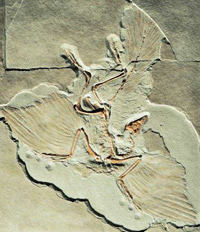At the end of Cretaceous period toothed birds and dinosaurs disappeared. By the Eocene period (50 million years ago), fossils of non-passerines, including ostriches, penguins and storks can be identified. The passerines appeared 36-45 million years ago. Giant birds such as the Moas of New Zealand and Elephant Birds of Africa survived until 10,000 years ago. Recent discoveries in North-east China of many small feathered theropod dinosaurs complicate our understanding of the evolution of birds. The recently discovered flight-capable Cryptovolans, was a bird having a keel and ribs with uncinate processes. In fact, Cryptovolans appears more 'bird-like' than Archaeopteryx which is missing some of these modern bird features. Because of this, some paleontologists and ornithologists have suggested that dromaeosaurs are actually basal birds whose larger members are secondarily flightless, i.e. dromaeosaurs evolved from birds and not the other way around. Modern birds are classified in Neornithes, which are split into the Paleognathae and Neognathae. The paleognaths include the tinamous and the ratites. The ratites are large flightless birds, and include ostriches, cassowaries, kiwis and emus. Some scientists suspect that the ratites independently lost the ability to fly, while others contend that the ratites were always flightless and are more directly related to the dinosaurs than other modern birds. The basal divergence from the remaining Neognathes was that of the Galloanseri, the superorder containing the Anseriformes and the Galliformes.
The evolutionary success of birds is evidenced by the wide variety of present-day forms. They have long been
popular subjects of study for taxonomists. The
classification of birds is a contentious issue. Traditional classifications are based mainly on morphological and anatomical
differences in structure, plumage, and so forth. More recently, behavioral traits, song, and biochemical
techniques (including DNA) have been employed.
Sibley & Ahlquist's Phylogeny and Classification of Birds
(1990) is a landmark work on the classification of birds. Yet, while there is general agreement as to the
families to which the 9,000 or so extant bird species belong, a variety of opinions exists on the
relationships within and between orders and families. |
 birding.in
birding.in
| Birds | Bird Diagram | Ornithology | Indian Sites | Bird Watching | Migration | North India | Birds of India | Haryana |
All rights reserved. Copyright © 2005-2013 Birds and birding in India. Disclaimer
website: Free Java Guide & Tutorials
